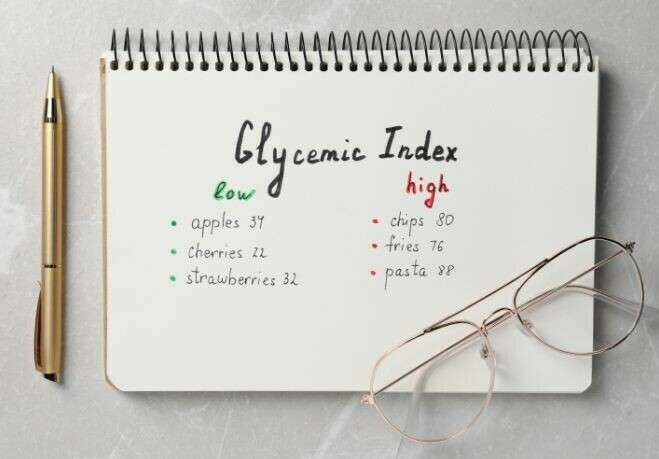Are you dealing with pre-diabetes or type 2 diabetes? Your next step must be to decide what foods you can eat. Eating Low Glycemix index foods can help you to control your diabetes.
What is the Glycemic Index?
The glycemic index (GI) is a ranking system that measures how quickly carbohydrates in foods raise blood sugar levels after consumption compared to a reference food (usually glucose or white bread). The difference between High GI foods and Low GI Foods is that foods with a high GI value are rapidly digested and absorbed, causing a rapid increase in blood sugar levels, while foods with a low GI value are digested and absorbed more slowly, resulting in a gradual rise in blood sugar levels.
Here is how the GI scale typically categorizes foods:
– Low GI: 55 or less
– Medium GI: 56-69
– High GI: 70 or above
The glycemic index is influenced by various factors including the type of carbohydrate, the amount of fiber and fat in the food, the degree of processing, and how the food is prepared.
Why you should eat Low Glycemic Index Foods?
Generally, foods with a low GI value are considered healthier choices because they provide a slower and more sustained release of energy, help regulate blood sugar levels, and may contribute to better appetite control and weight management.
Eating low glycemic index (GI) foods offers several potential benefits for health and well-being:
1. Better Blood Sugar Control
Low GI foods are digested and absorbed more slowly, leading to a gradual rise in blood sugar levels. This can help prevent spikes and crashes in blood sugar, promoting more stable energy levels throughout the day.
2. Weight Management
Low GI foods tend to be more filling and can help control appetite, leading to reduced calorie intake and potentially aiding in weight loss or weight maintenance efforts.
3. Improved Satiety
Foods with a lower glycemic index value often provide a greater feeling of fullness and satisfaction after eating, which can help prevent overeating and unnecessary snacking.
4. Reduced Risk of Chronic Diseases
Consuming a diet rich in low GI foods has been associated with a lower risk of developing chronic diseases such as type 2 diabetes, cardiovascular disease, and certain types of cancer.
5. Enhanced Sports Performance
Low GI foods can provide a steady source of energy during physical activity, helping to sustain endurance and performance levels over longer periods.
6. Better Digestive Health
Many low-GI foods are rich in fiber, vitamins, and minerals, which can promote digestive health and regularity.
7. Stable Mood and Mental Health
Avoiding blood sugar spikes and crashes by consuming low-GI foods may contribute to a more stable mood and mental well-being, reducing the risk of mood swings and irritability.
Overall, incorporating low glycemic index foods into your diet can be a valuable component of a balanced and nutritious eating plan, supporting overall health and vitality.
Managing Blood Sugar Naturally with Low-GI Foods
1. Non-starchy vegetables
e.g; broccoli, cauliflower, spinach, kale, bell peppers).
Below are the GI of these vegetables:
Broccoli:-15
Cauliflower:-15
Spinach:-15
Kale:-5
Bell Peppers:-15
2. Legumes
e.g; lentils, chickpeas, kidney beans, black beans)
Below are the GI of these legumes:
Lentils:-32
Chickpeas:-28
Kidney Beans:-24
Black Beans:-30
3. Whole grains
e.g; such as quinoa, barley, bulgur, whole wheat)
Below are the GI of these whole Grains:
Barley:-28
Whole Wheat:-45
4. Nuts and seeds
e.g; almonds, walnuts, chia seeds, flaxseeds
Almonds:-15
Walnuts:-15
Chia Seeds:-30
Flaxseeds:-35
5. Berries
e.g; strawberries, blueberries, raspberries
Below are the GI of these berries:-
Strawberries:-41
Raspberries:-26
Blackberries:-25
6. Citrus fruits
e. g; such as oranges, grapefruits
Below are the GI:-
Oranges:-43
Grapefruits:-25
7. Apples
GI:-36
8. Pears
GI:-30
9. Cherries
GI:-20
10. Greek yogurt (unsweetened)
GI:-11
11. Soy products (such as tofu, tempeh)
GI:-15
12. Sweet potatoes
GI:-50
13. Raw Carrots
GI:-16
14. Oats (steel-cut or rolled oats)
GI:-53
15. Brown rice
GI:-50
The Bottom Line
These foods are typically slower to digest and absorb, resulting in a slower rise in blood sugar levels compared to high-GI foods. However, it is essential to consider portion sizes and individual responses to foods, as factors like cooking methods and combinations with other foods can also affect glycemic response.
In addition to this, it is important to note that the glycemic index is just one factor to consider when making dietary choices. Portion sizes, overall nutrient content, and individual health goals also play significant roles in determining the healthfulness of a food choice.
ALSO READ:

